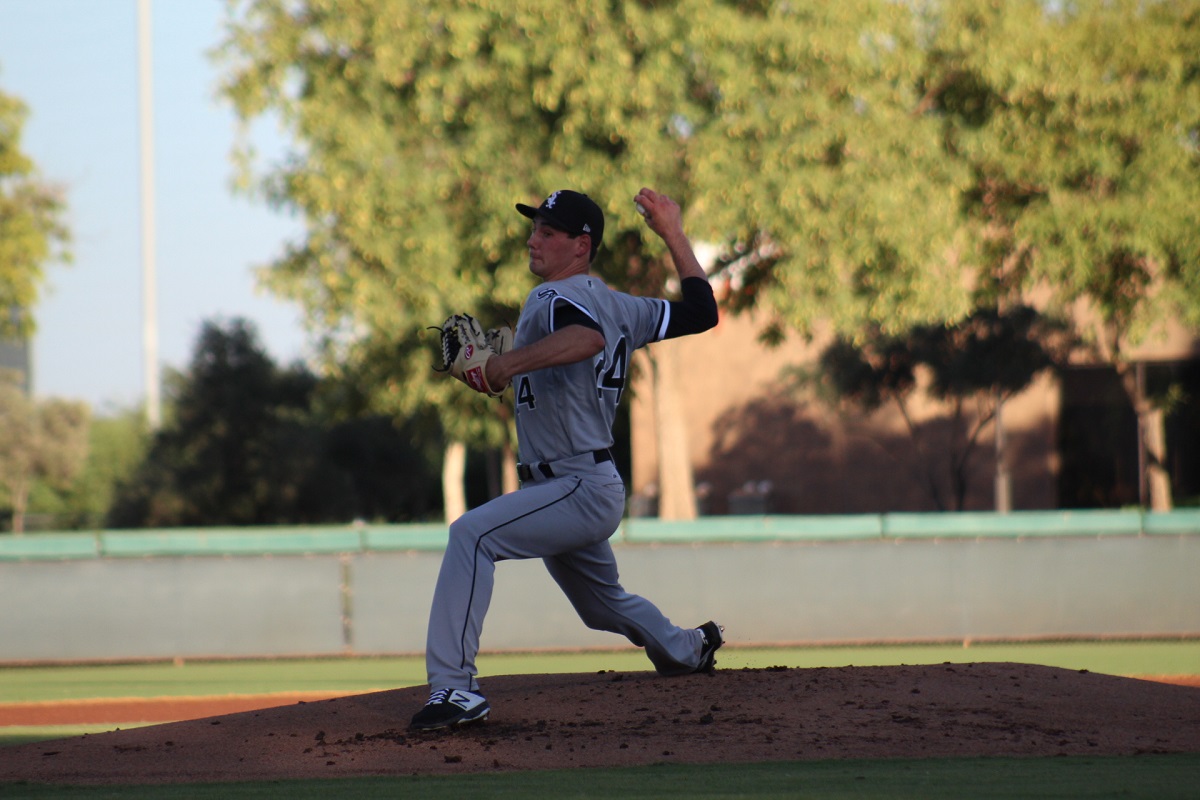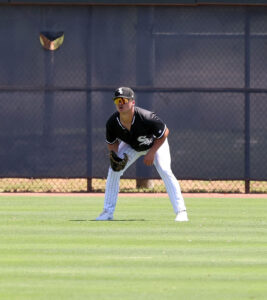Accelerated Learning Curve: Andrew Dalquist gets an education in Schaumburg

Photo by Sean Williams
“I had to gain experience really quickly on my own. Going from the high school world, being a kid, right into the working environment,” said 2019 third-round draft pick Drew Dalquist in a phone interview with FutureSox.
Don’t be confused by the name. This is the same pitcher the White Sox awarded a $2 million signing bonus last summer with a mid 90s fastball, repeatable delivery and a penchant for pounding the strike zone.
“My friends call me Drew,” he said. “That’s how I introduce myself.”
Drafting players straight out of high school is commonplace in professional baseball, but due to the unique set of circumstances presented by COVID and lack of a minor league season, the 6-foot-1 175-pound right-hander has had to make that transition faster than most.
“I was going to stay in extended spring training for a little while,” Dalquist said. “I would have had an innings limit that would have created problems at the end of the year. If I would have gone straight into full season, I would’ve had to have been shut down. So, I was going to stay in extended for a little while.”
GROWING UP IN SCHAUMBURG
The lack of a minor league season hasn’t been entirely detrimental. By getting time in Schaumburg, Dalquist has been able to work with veterans who have given him tips and tricks to help him adjust to life as a professional athlete.
There’s a few tidbits that I’ve picked up on from being in Schaumburg with the older guys. Mainly their work ethic and how they go about their days. And I learned a lot of that in Arizona with the big leaguers out there. They have their routine. They go through it every day. There’s a lot of time spent working on your craft. Going from high school where you have a two-hour practice, it’s a lot more on your own. You have to set your own schedule. I wasn’t expecting that. I learned very, very quickly you get here at this time, but you may not have anything to do for 30 minutes, but you want to get there early to prepare yourself for what you have to do that day. From my experience so far, I think learning the pro system at a younger age is going to benefit me. Just being able to solely focus on baseball, saying okay, this is my job now and being able to focus on it alone.
Andrew Dalquist
Dalquist has taken full advantage of the opportunity of his access to more experienced ballplayers.
“I ask questions, just to try to pick their brains for as much knowledge you can get,” he said. “I wouldn’t get that in a normal year, so in a way, this whole not playing stinks, but it’s been a great learning experience for me.”
ON THE PRACTICE FIELD
Pitching against hitters with big-league experience in Schaumburg has also helped expedite the learning process for the prospect out of Redondo Beach, California.
It’s kinda crazy to go up against guys that have played in the major leagues or guys that are really close to it. It’s different. They take different at-bats. They watch pitches that in high school guys would swing and miss at. Another thing I noticed is that the strike zone is a lot smaller than high school. You have to make more precise pitches to better hitters. It’s been an interesting learning experience for me. If you throw a strike or something over the middle of the plate, it’s gonna at least be made contact with. Whether it’s a home run, a single or a fly out depends on the location and the swing, but they don’t miss pitches that are hittable.
Andrew Dalquist
Being in camp with potential big leaguers has given Dalquist access to technology that he didn’t have in high school.
“We have a portable Trackman and a Rapsodo,” he said. “We set them up for every single bullpen and all the games. We look at it and you can see your spin rate, your spin efficiency, vertical break, horizontal break, and that stuff. I use it a lot with (Everett) Teaford and (Matt) Zaleski. They are big into the numbers. If your spin rate is good, your spin efficiency and your spin access allow you to get carry on your fastball. I didn’t have any of this in high school.”
LEARNING EVEN MORE
“Coming into this season, I wanted to work on my pitch shape and my curveball,” said Dalquist. “I changed the grip on that pitch a little bit at the end of last season, and I didn’t feel that comfortable with it. I wanted to get that down and work on my other pitches. Last spring, I tried to throw a slider, which wasn’t very good. This summer, I started working on it a little bit. It’s a work-in-progress as a new pitch. I’m happy with the way it’s developed the past couple months.”
As expected at such a young age, Dalquist is working on more than developing his breaking pitches.
“I’m working on command of my fastball and the shape of my off-speed pitches — being able to sequence off of them,” he said. “I’m working on a bit of fine-tuning my mechanics. Obviously, every time you go out there, you find something that you can work on.”
On the surface, this may appear as an enormous task, but Dalquist feels good about the progress he’s made since joining the White Sox.
“Fortunately for me, I hit a lot of the big goals,” the 2019 draft pick shared. “I still have things that I need to work on to get to the level that I want to be at. But for this season, I’ve accomplished more than I would’ve in a normal year.”
BUILDING STRENGTH
“Getting into three games last year helped me get used to being in a five-day rotation as opposed to a seven-day,” he said. “It snuck up on me a little bit the last week (of 2019). It was a good learning experience.”
“The five days is definitely a lot different,” Dalquist continued. “You can’t take any days off. You have to throw every day. The difference between high school and pro ball is a lot for a starter. Unfortunately, I didn’t get build off of it until I got to Schaumburg. I’m slowly working into a five-day rotation.”
THE ULTIMATE GOAL
Still a teenager, it obvious Dalquist has to it in a lot of work to reach his ultimate goal of pitching in meaningful games on the Southside of Chicago.
“I need to keep developing and working on my pitches,” said the soon-to-be 20-year-old. “And get stronger in the weight room. If everything works out the way that I want to, I’ll end up making it.”
Given his mental approach, maturity, and natural talent, the number 10 prospect on FutureSox’s Top 30 prospect rankings should be on your radar. If things return to normal next spring, expect him to be pitching at the Class-A level sooner than later.
Photo credit: Sean Williams/FutureSox
Want to know right away when we publish a new article? Type your email address in the box on the right-side bar (or at the bottom on a mobile device) and click create subscription. Our list is completely spam free, and you can opt out at any time. Also, consider supporting FutureSox on Patreon! You can get early access to special articles and Patreon-only posts, in addition to more benefits.
Shop our exclusive merchandise! Show your support with FutureSox apparel.




